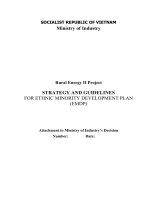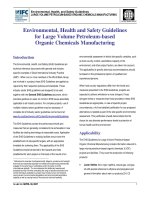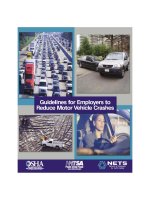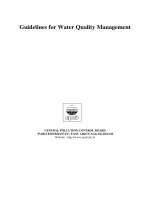USEPA REGION 9 TECHNICAL GUIDELINES FOR ACCURATELY DETERMINING VOLATILE ORGANIC COMPOUND (VOC) CONCENTRATIONS IN SOIL AND SOLID MATRICES potx
Bạn đang xem bản rút gọn của tài liệu. Xem và tải ngay bản đầy đủ của tài liệu tại đây (44.2 KB, 10 trang )
UNITED STATES
ENVIRONMENTAL PROTECTION AGENCY
REGION 9
Quality Assurance Office
75 Hawthorne Street
San Francisco, CA 94105-3901
USEPA REGION 9 TECHNICAL GUIDELINES
FOR
ACCURATELY DETERMINING
VOLATILE ORGANIC COMPOUND (VOC)
CONCENTRATIONS IN SOIL
AND SOLID MATRICES
R9QA/05.2
FINAL
December 2005
EPA Region 9 Technical Guidelines for Accurately Determining
Volatile Organic Compound Concentration in Soil and Solid Matrices
December 2005 - 2 -
FOREWORD
The U.S. Environmental Protection Agency (EPA) is authorized to make
decisions affecting public health and the environment. With the knowledge that
there is an inviolable trust in the Agency, EPA mandated that environmental data
collected by and for the Agency be of known quality, and, as appropriate, legally
defensible in relation to the decisions to be made based on them. The Agency-
Wide Quality System, EPA Order 5360.1 A1, EPA Quality Manual for
Environmental Programs, May 2000, and EPA Order 5360.1 A2, Policy and
Program Requirements for the Mandatory Agency-Wide Quality System, May
2000 (supersedes EPA Order 5360.1, 1984) defines this mandate. The Agency-
Wide Quality System is intended to ensure that decision makers are provided the
necessary knowledge and confidence on which to base their decisions.
The responsibility for planning, developing and implementing the EPA Region
9’s Quality System resides with the Regional Quality Assurance Manager
(RQAM) and the Quality Assurance Office (QA Office).
These guidelines have been developed by the RQAM/QA Office to support the
mission of EPA Region 9.
These guidelines update and replace the EPA Region 9 “Regional Interim Policy
for Determination of Volatile Organic Compound (VOC) Concentrations in Soil
and Solid Matrices,” June 23, 1999.
If you have any questions, please contact the Region 9 QA Office.
EPA Region 9 Technical Guidelines for Accurately Determining
Volatile Organic Compound Concentration in Soil and Solid Matrices
December 2005 - 3 -
ACKNOWLEDGEMENTS
EPA Region 9 would like to thank all the technical reviewers, from the
environmental testing and sampling industries and from State and Federal
agencies, who provided input to this document and its predecessor.
EPA Region 9 Technical Guidelines for Accurately Determining
Volatile Organic Compound Concentration in Soil and Solid Matrices
December 2005 - 4 -
TABLE OF CONTENTS
FOREWORD 2
ACKNOWLEDGEMENTS 3
TABLE OF CONTENTS 4
1.0 SUMMARY 5
2.0 PURPOSE 5
3.0 BACKGROUND 5
4.0 SCOPE 6
5.0 GUIDELINES 6
6.0 ADDITIONAL CONSIDERATIONS 8
7.0 ADDITIONAL BACKGROUND 9
8.0 REFERENCES 10
EPA Region 9 Technical Guidelines for Accurately Determining
Volatile Organic Compound Concentration in Soil and Solid Matrices
December 2005 - 5 -
1.0 SUMMARY
These guidelines address methods for: (1) handling of samples as intact soil cores; (2)
preserving samples; (3) storing samples in hermetically sealed containers; and (4)
minimizing analyte losses due to direct volatilization (both in the field and the
laboratory) and biodegradation. Region 9 believes that following these guidelines is
an important part of ensuring that accurate concentrations of VOCs are measured.
Therefore, the procedures by which data are generated for or by Region 9 should
follow project and/or program specific methods for field sample collection and
laboratory sample handling which adhere to these guidelines. Specific procedures
should be included in a quality assurance project plan (QAPP) or sampling and
analysis plan (SAP).
2.0 PURPOSE
EPA Region 9 has developed technical guidelines to help ensure that sampling and
analyzing for Volatile Organic Compounds (VOCs) in soil and solid matrices are
conducted in a manner that achieves accurate, technically defensible data. Region 9’s
guidelines, which are intended to apply whenever VOC sampling in and analysis of
soil and solid matrices are conducted, are consistent with United States
Environmental Protection Agency (USEPA) Office of Solid Waste test methods.
These are included as part of a compendium of over 200 documents in “Test Methods
for Evaluating Solid Wastes and Physical/Chemical Methods, SW-846” (hereafter
“SW-846”), which are applicable when such sampling is conducted under the
Resource Conservation and Recovery Act program. Region 9’s guidelines provide
greater flexibility than SW-846. These guidelines also have general applicability to
other EPA programs where VOC data are collected for quantitative uses.
Region 9 recognizes that there may be methodologies other than those referenced in
these guidelines that may also measure VOC concentrations in solid matrices. The
use of alternative methods is acceptable, but only after credible method validation
studies have been performed and documented.
These guidelines are based on the best scientific information available at this time,
and therefore, are subject to further clarifications and additions as further peer
reviewed and validated research or improved techniques become available.
3.0 BACKGROUND
In the 1990’s, a number of studies were conducted to evaluate traditional VOC
sampling and analysis techniques to determine whether they provided data that
accurately reflected environmental conditions. At the time, the accepted, traditional
sampling methodologies included methods such as the use of glass jars with minimal
head space and/or sealed sampling sleeves. These studies determined that these
techniques often resulted in inaccurately low measurements of VOCs due to
volatilization and biodegradation losses from the sample media. These in turn may
have lead to an underestimate of the risk posed by VOC contaminants to public health
EPA Region 9 Technical Guidelines for Accurately Determining
Volatile Organic Compound Concentration in Soil and Solid Matrices
December 2005 - 6 -
and the environment. To address these technical deficiencies, USEPA’s Office of
Solid Waste, developed (as part of SW-846) Method 5035, “Closed-System Purge-
and-Trap and Extraction for Volatile Organics in Soil and Waste Samples,” and
Method 5021, “Volatile Organic Compounds in Soils and Other Solid Matrices Using
Equilibrium Headspace Analysis,” to describe procedures and protocols for the
collection and analysis of solid samples. (Method 5035 was updated to Method
5035A in July 2002. The update includes an Appendix, “The Collection and
Preservation of Aqueous and Solid Samples for Volatile Organic Compound (VOC)
Analysis,” a useful reference for VOC sampling and analysis.). Soil was deleted as
an option for Method 5030, “Purge-and-Trap for Aqueous Samples,” (soil sample
extracts and certain sample types still reference method 5030 for analysis).
4.0 SCOPE
Region 9 intends to follow the procedures set forth in these guidelines when it is
determining VOC concentrations in soil and solid matrices. In order to help ensure
that data generated are of known and appropriate quality and accurately reflect
environmental conditions, Region 9 recommends that USEPA contractors and
grantees, Federal Facilities, and other entities producing data for Region 9 decision-
making follow the procedures set forth herein.
If methodologies that differ from those noted in these guidelines are followed, copies
of documents which support the alternative methodology, including method
validation studies, should be submitted with the data.
5.0 GUIDELINES
To help ensure accurate measurements, Region 9 recommends that these guidelines
be followed whenever VOCs in soil or other solid matrices are sampled and analyzed.
These guidelines address methods for: (1) handling of samples as intact soil cores; (2)
preserving samples; (3) storing samples in hermetically sealed containers; and (4)
minimizing analyte losses due to direct volatilization (both in the field and the
laboratory) and biodegradation. Region 9 believes that following these guidelines is a
scientifically important part of ensuring that accurate concentrations of VOCs are
measured. Therefore, the procedures by which data are generated for or by Region 9
should follow project and/or program specific methods for field sample collection and
laboratory sample handling referred to in these guidelines. These procedures should
be documented in a quality assurance project plan (QAPP) or sampling and analysis
plan (SAP).
Region 9’s guidelines for measuring VOC concentrations in soil and other solid
matrices include the following:
1. Samples should be handled as intact soil cores until being transferred
into methanol or into the container that will be used for analysis.
Volatilization of VOCs can occur quickly from many matrix types. By preserving a
cohesive matrix and minimizing surface area exposed to the atmosphere, VOC losses
EPA Region 9 Technical Guidelines for Accurately Determining
Volatile Organic Compound Concentration in Soil and Solid Matrices
December 2005 - 7 -
can be minimized over a short duration of time. Therefore, Region 9 recommends
that coring techniques be used which preserve soil integrity and cohesion.
However, these guidelines do not address the impact of drilling techniques on the
collection of a representative VOC sample. Therefore, site/program QAPPs and SAPs
should address the impact of all collection techniques on sample integrity and select
those appropriate for the project data quality objectives (DQOs). Potential VOC
losses due to drilling techniques include, but are not limited to: sample compression
and loss of pore space; introduction of air into the sample matrix; mechanical heat
introduced in the drilling process; and volatilization from prolonged periods in a non-
hermetically sealed sampling apparatus.
Further, solid matrices that are not amenable to the use of a coring technique should
be collected in such a way as to preserve their integrity. Transferring of these solids
with spatulas or similar devices into sampling containers is discouraged as this
disrupts the sample pore spaces and greatly increases the sample surface area
available for volatilization. For soil piles, fresh (unexposed), soil at an adequate depth
(representative of concentrations from the interior of the pile) should be sampled.
Gravel or concrete samples may need to be manually transferred into VOC sampling
containers quickly and in a condition and manner that minimizes VOC losses.
2. Samples should be stored in containers which can be reliably sealed to
prevent volatilization losses over the project specified analytical
holding time.
Significant volatilization has been shown to occur when samples are stored in jars,
capped sleeves and other containers that do not provide reliable seals. Therefore,
Region 9 recommends, consistent with the results of recent studies, that samples be
stored in vials with sufficiently thick Teflon™/silicon septa as are commonly used for
storage of water samples, to prevent VOC losses over the sample holding time.
3. Samples should be analyzed or chemically preserved with acid or
methanol, within 48 hours of collection.
Soil samples stored in sealed vials have been shown to undergo significant
biodegradation over time periods greater than 48 hours. Holding time guidelines for
VOCs are given in SW846, Method 5035A, Appendix A, Table A.1 “Recommended
VOC Sample Preservation Techniques and Holding Times.” The holding time for
preserved soil samples should be interpreted as 14 days from the time of sample
collection (stored at 4±2
o
C). Due to potential biodegradation, samples stored in sealed
containers, but not chemically preserved, should not be stored for more than 48 hours
prior to analysis or chemical preservation. On a project/program specific basis,
Region 9 will consider other alternatives to extend the holding time of soils that have
EPA Region 9 Technical Guidelines for Accurately Determining
Volatile Organic Compound Concentration in Soil and Solid Matrices
December 2005 - 8 -
not been chemically preserved. Holding time will be considered as cumulative.
Exceptions should be documented in a QAPP or a SAP submitted to and approved by
the Region 9 QA Office.
It should be noted that some soil types have been shown to exhibit significant
degradation of aromatic VOCs in less than 48 hours (Hewitt, et. al., 1999,
Environmental Testing and Analysis). Also, Sorini, et. al., (2002, Soil Sediment &
Water) observed significant differences between samples that were extruded directly
into methanol and samples where methanol was added at a later time to soil extruded
into empty VOA vials (where methanol was added through the septum). Based on
these findings, where project or program DQOs require a higher degree of accuracy
soil samples may need to be chemically preserved in the field.
Care should be taken in choosing preservatives. For example, Method 5035 notes
that, “Soil samples that contain carbonate minerals (either from natural sources or
applied as an amendment) may effervesce upon contact with the acidic preservative
solution in the low concentration sample vial.” Therefore, calcareous soils that
effervesce on contact with the preservative solution, which is intended for low-level
samples, should be preserved using an alternative technique.
As an alternative to chemical preservatives, several studies have shown that freezing
of unpreserved soils, at -7
o
C or less, is an effective means of slowing the
biodegradation process. If freezing is determined to meet project or program DQOs,
samples should be frozen in containers that have an air tight seal that can be
maintained while frozen. Because water expands when frozen, samples extruded into
water or samples with extremely high moisture content may rupture or compromise
the seal of the storage container.
4. Steps should be taken to minimize exposure of each sample core to the
atmosphere in the field and laboratory.
As noted by Hewitt and Lukash, “Uncontrollable volatilization losses occur within
seconds of exposure for samples with a large surface / mass ratio. Thus, soils
obtained in small diameter coring devices should be extruded directly into
appropriately prepared analysis vials.” (CRREL Special Report 96-5).
6.0 ADDITIONAL CONSIDERATIONS
Field Laboratories: The use of field laboratories to analyze samples within several
hours of collection is an alternative to prevent loss of volatiles in transit and storage.
The sample collection and analysis procedures should follow the guidelines above.
Note that, for extremely short holding times, chemical preservation is not needed and
sample storage containers may differ than those used for “fixed” laboratory analysis
as long as these containers “prevent volatilization losses over the project specified
analytical holding time.” Additionally, the quality control criteria and quality
EPA Region 9 Technical Guidelines for Accurately Determining
Volatile Organic Compound Concentration in Soil and Solid Matrices
December 2005 - 9 -
assurance system used by a field laboratory must be adequate for generation of data
which will meet project DQOs.
Addition of Surrogates and Matrix Spiking Compounds in the Field: It is best to
add analytical surrogate and matrix spiking compounds into soils prior to sample
extraction, using water or a solvent. Method 5035A does not incorporate the addition
of these compounds prior to extraction in the field. Because this is an important
control check on the analytical process, it may be appropriate to incorporate a
procedure which adds surrogate and/or matrix spiking compounds prior to extraction
for some project/program DQOs. This procedure should be implemented in
consultation with the analytical laboratory.
Soil Gas: These guidelines are not intended to address data quality issues associated
with collection of soil gas samples for VOCs in conjunction with, or as a substitute
for, soil samples. Soil gas is the preferred data type to meet the quality objectives of
some subsurface characterization activities. There are also scenarios where soil gas
data are unacceptable for decision making (e.g., in excavated soils and when
determining disposal or treatment options, or for determining concentrations of VOCs
that have a high affinity for the soil matrix).
7.0 ADDITIONAL BACKGROUND
Traditional practices for the sampling and analysis of volatile organic compounds
(VOCs) in soil have been shown to have a significantly low bias of inconsistent
magnitude (Grant, 1996) resulting from volatilization (Hewitt, 1996) and
biodegradation (Hewitt, 1994). Hewitt and Lukash (Hewitt, 1996) demonstrated that
capped sleeves can show substantial losses in less than one day. Hewitt and Lukash
also demonstrated volatile losses in uncapped core liners of up to 90% in less than 40
minutes for trichloroethene (TCE). Because other analytes, in various matrix types,
can have higher mobility than those tested, substantial losses may occur in a shorter
period of time. Grant, Jenkins and Mudambi (Grant, 1996) examined split sampling
results from a cross section of laboratories. For VOCs in soil they noted that, “The
magnitude of this scatter [for a typical data comparison] is so large that it is
impossible to recommend effective limits of acceptability. Instead, we believe that
steps are urgently needed to improve data quality.” Hewitt (1994) noted that
biodegradation of benzene and toluene in soil samples stored in sealed glass ampules
at 4
o
C for 14 days could be substantial, demonstrating a need for the use of chemical
preservatives. Turriff and Reitmeyer (1998) observed that a variety of soil matrices
could be held for 48 hours at 4
o
C, in sealed zero headspace containers, without
substantial VOC losses. Additionally, Turriff and Reitmeyer demonstrated that
freezing was an option to extend holding times of En Core™ sampling devices.
Because volatile losses have been linked to disturbance of the soil matrix and
exposure to the atmosphere, samples should be handled in intact soil cores and stored
in hermetically sealed vessels in both the field and the laboratory.
EPA Region 9 Technical Guidelines for Accurately Determining
Volatile Organic Compound Concentration in Soil and Solid Matrices
December 2005 - 10 -
8.0 REFERENCES
American Society for Testing and Materials (2003) Standard Guide for Sampling
Waste and Soils for Volatile Organic Compounds, ASTM Guide D 4547-03
Grant, C.L., T.F. Jenkins, and A.R. Mudambi (1996) Comparison Criteria for
Environmental Chemical Analyses of Split Samples Sent to Different Laboratories,
Corps of Engineers Archived Data. US Army Cold Regions Research and
Engineering Laboratory, Special Report 96-9.
Hewitt, A.D. (1994) Concentration Stability of Four Volatile Organic Compounds in
Soil Subsamples. US Army Cold Regions Research and Engineering Laboratory,
Special Report 94-6.
Hewitt, A.D. (1995) Chemical Preservation of Volatile Organic Compounds in Soil
Subsamples. US Army Cold Regions Research and Engineering Laboratory, Special
Report 95-5.
Hewitt, A.D. and J.E. Lukash (1996) Obtaining and Transferring Soils for In-Vial
Analysis of Volatile Organic Compounds. US Army Cold Regions Research and
Engineering Laboratory, Special Report 96-5.
Hewitt, A.D. (1997) Preparing Soil Samples for Volatile Organic Compound
Analysis, US Army Cold Regions Research and Engineering Laboratory, Special
Report 97-11.
Hewitt, A.D. (1999) Storage and Preservation of Soil Samples for Volatile
Compound Analysis, US Army Cold Regions Research and Engineering Laboratory,
Special Report 99-5.
Hewitt, A.D. (1999) Frozen Storage of Soil Samples for Volatile Organic Compound
Analysis, Environmental Testing and Analysis, Vol 8(5), 1999, pp. 18-25
Sorini S.S., Schabron, J.F., and J.F. Rovani, Jr. (2002) Evaluation of VOC loss
from Soil Samples: Extrusion into Empty VOA Vials, Refrigerated Storage, and
Methanol Injection in Preparation for Volatile Organic Analysis, Soil Sediment &
Water, April/May 2002
Turriff, D. Ph.D. and C. Reitmeyer (1998) Validation of Holding Times for the
EnCore™ Sampler. En Novative Technologies, Inc.
USEPA, SW-846 Method 5035A Closed System Purge-and-Trap and Extraction for
Volatile Organics in Soil and Waste Samples, USEPA Office of Solid Waste and
Emergency Response, July 2002









